The Ultimate Step-By-Step Guide to Changing A Radiator
In this guide, we’ll give you all the knowledge you’ll need to successfully remove and replace a radiator and protect your central heating against damage.
Removing and replacing radiators that are no longer working will save you money on your energy bills and ensure that your home is heated effectively and efficiently.
Please Note – Replacing a radiator is a job for a pretty competent DIYer, so only continue reading if you’re confident in your plumbing skills. If you’re not, it may be best to call a qualified plumber.
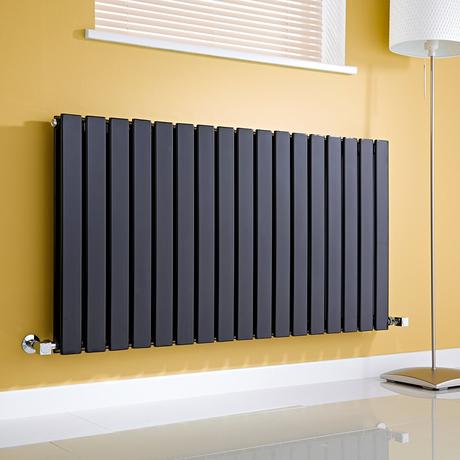
WHAT TOOLS AND MATERIALS WILL I NEED?
- Your new radiator (goes without saying really)
- New radiator brackets
- 2 adjustable spanners
- A washing up bowl
- A radiator bleed key
- Pipe/Cable/Stud detector
- A drill – Hammer drill for masonry walls, or a drill driver for internal walls
- A masonry drill bit
- Some steel wool
- Cloths or a rag for spillages
- PTFE tape (also called thread seal tape)
- Somebody to give you a hand
BEFORE YOU BEGIN
It’s important to check the wall you intend to install your radiator on before beginning the process – as they say, “fail to prepare, prepare to fail”.
If you come across any cracks or crumbling bits of plaster or masonry, it’s probably worth your time to make some repairs before you fit your shiny new radiator.
What kind of walls do you have?
Studwork Walls
If the wall you are affixing your radiator to is made from plasterboard, with a hollow space behind it – a studwork wall – you’ll need to determine exactly where the studs and noggins run.
The studs and noggins are the horizontal or vertical lengths of timber that your plasterboard has been attached to. This is where your digital detector comes in handy – they even have one that works with your phone, but it is pretty expensive – though you can pick a good quality one up for around £30-40.
The studs in a plasterboard wall form the strongest part, so your replacement radiator will have to be attached to these in order for it to remain stable and safe. Depending on the location of these studs, you could be limited on the size, shape and material of the radiator you can safely use in the space.
Masonry & Brickwork Walls
If you are attaching your radiator to a wall constructed from solid masonry (bricks and blocks held together with cement), you’ll have a wide variety of radiators to choose from to get the job done.
As this type of wall is far stronger than any studwork walls – with the correct fixings and brackets – larger radiators can be placed on almost any part of the wall; even up high if you really want to…
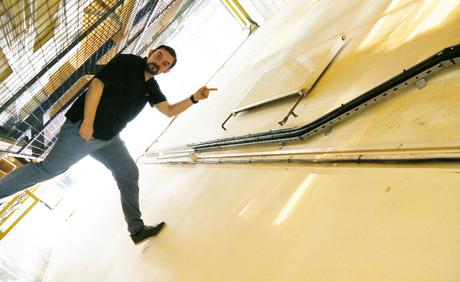
I WANT TO REPLACE MY RADIATOR RIGHT AWAY!
Right, so you don’t want to read through this entire guide?
No worries!
Follow these 10 Simple Steps To Replacing Your Radiator and you’re away!
- Turn off your heating and isolate the radiator.
- Put your washing up bowl under the radiator valve.
- Open the radiator bleed nipple and loosen the connection between the radiator and the valve allowing water to feed into the bowl.
- Lift your radiator and remove any remaining water from the radiator.
- Remove the valve connectors and clean them.
- Wrap the valve connectors with PTFE tape around 17 times.
- Screw in the valve connectors and re-connect your radiator to the system.
- Check that all connections are secure and there are no leaks or drips.
- Turn your heating back on.
- Get warm and toasty with your newly installed radiator.
HOW TO REMOVE AND REPLACE A RADIATOR
The best way to make replacing a radiator a whole lot easier is to choose a replacement that has identical pipe centres – the distance between the two water pipes – that your old model had.
If you pick one that is a different size and shape – say you’re replacing a panel convector with a vertical designer radiator – you’ll need to drain down the system and make alterations to your pipework.
This is a relatively simple job to do and modern plumbing fittings are very easy to work with, so you’ll give yourself a wider range of radiators to choose from if you do it. Just be sure to drain the system properly before you begin and remove the flooring and any skirting boards that are in your way to get proper access to the pipework.
Remember – Plumbing that involves pipework is covered by a variety of safety regulations, so if you are unsure of what the best practices are talk to a qualified plumber.
Step One
First things first – turn off the central heating and isolate the radiator you want to remove by shutting off the valves at either end.
Turn the manual valve clockwise until you can’t turn it anymore – if you have a TRV (thermostatic radiator valve) turn it all the way past zero or to the ‘off’ position.

If you have a lockshield valve at the other end then simply pull off the plastic shield and – with an adjustable spanner – turn the shaft clockwise, being sure to count the number of turns so you can set your new radiator to the same flow rate.
Top Tip – Have a notebook handy if you are replacing a few different radiators; that way you can keep a tab on all of the lockshield valve turns you make and any other adjustments.
Step Two

Place your washing up bowl under the valve to catch the water as it begins to drain away.
Using your adjustable spanner again, loosen one of the cap nuts that connect your radiator to the valve. You might have to use the second spanner to hold the valve body securely and prevent the valve from turning and buckling the pipework.
Step Three
Open the bleed valve at the top of your old radiator and loosen the connecting cap nut between the valve and the rad to drain the water away and into the bowl.
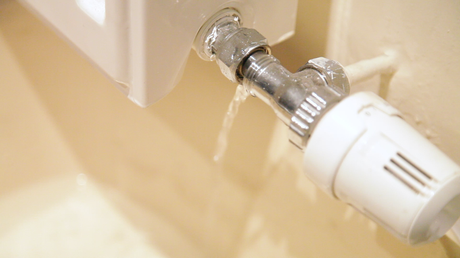
If you have an old central heating system with some aging radiators the water inside may be filthy, so be ready to wipe up any spillages with your cloths.
If your washing up bowl isn’t deep enough to catch all of the water, just re-tighten the connecting cap nut and pour the water away – before repeating the process until all of the water has been drained – once there’s no more water coming through, disconnect the valve at the opposite end of the radiator.
Step Four
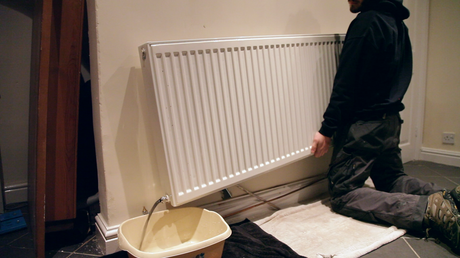
Lift your radiator from its mounting brackets and tilt it to drain any remaining water – you may need a hand doing this if you have a larger radiator – and stuff an old rag or some tissue into the outlets at either end of the radiator to stop it from leaking.
If the brackets in place don’t suit your new style radiator take them off the wall and replace them with some new, more suitable ones.
If you need to drill into the wall to do this, make sure you check what’s behind where you intend to drill with a digital detector before you take the plunge.
They’re really easy to use and will tell you right away if there are any unforeseen obstacles to you completing the work. Just run it over the surface of the wall and it will tell you instantly if and where any hazards might be lurking.
Top Tip – At this point it might be a good idea to fit some reflective radiator foil to the wall behind your new radiator. This can help reduce the cost of heating your home by reflecting heat back into the room – a great addition for radiators that may be sited on your colder outside walls.
Step Five
Using your adjustable spanner carefully remove the valve connectors from your old radiator.
Clean the connectors with wire wool and wind your PTFE tape around the threads between 5 and 10 times to ensure that a safe and watertight seal is created.
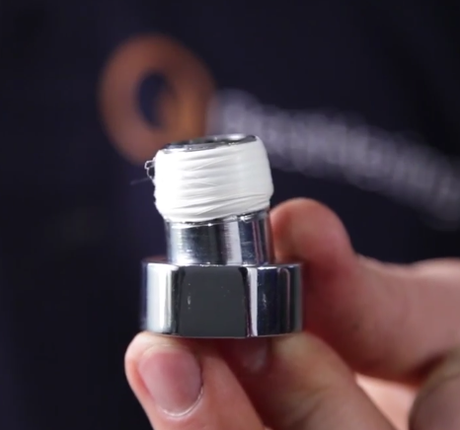
Screw the connectors into your new radiator, being sure to tighten them fully and then hang the radiator on the wall.
Connect the valves and reset them – using the number of turn measurements that you took earlier – and allow the water to enter the radiator.
At this point, you will need to slightly open the radiator bleed valve to allow the air to escape and help fill the radiator. Just close it again when water begins to spurt or bubble out of the bleed nipple.
Check all of the valves and joints for any leaks – dry and tighten them if necessary – before turning your central heating back on and re-checking again for any drips.
And there you have it, you should have a nice shiny new radiator taking pride of place on your wall.
Top Tip – After removing your radiator and replacing it for a new one, it’s a good idea to go around and bleed all the other radiators in the system as air can move through pipework and cause your central heating system to make annoying banging sounds.
ADDING CORROSION INHIBITOR
Even if you’ve only gone to the trouble of replacing one radiator it’s probably a good idea to flush your entire heating system and add some central heating protector liquid – otherwise known as a corrosion inhibitor.
Corrosion inhibitor will help to prevent damage to the internal workings of your heating system. Having water flowing against metal in a constant motion will cause that metal to rust; inevitably creating sludge in the system and sometimes stopping it working altogether.
It’s normal to add inhibitor when the system is first installed, but it can be added later too. It’s very important that you use a product that is compatible with the materials in your boiler, pipes and radiators – if you are unsure of this, be sure to consult a qualified plumber.
Whenever a radiator is replaced corrosion inhibitor will be lost from the system, meaning that it will not be fully protected against the effects of sludge and corrosion. It’s very important therefore to ensure that the system is properly topped up after you change the radiator.
How much corrosion inhibitor you use is dependent upon the size of your house and the number of radiators you have – in some cases more than one bottle of inhibitor may be required, so as always, refer to the manufacturer’s guidelines.

If you have an older central heating system it may be a good idea to completely flush the system before adding any corrosion inhibitor, as this will help to remove any sludge that has already built up over time.
Turn your heating off and allow the water to cool down then drain the system completely. Refill and then drain again and repeat the process until the water begins to run clear.
Check the manufacturer’s instructions before adding the inhibitor and pour the correct quantity into the feed-and-expansion cistern before filling the system completely. Once poured, turning the boiler and pump back on will mix the corrosion inhibitor thoroughly with the water.
Just in case you are struggling with draining down and filling up your system, here’s a couple of handy videos on how to do both.
DRAIN DOWN
FILL UP
And if you get really stuck trying to install a new radiator – we’ve got a video guide for that too!
Good luck trying this out for yourself.


